New Rotary
Club Formed
In Guam Charter Approved
Herald -- September 2, 1939 |
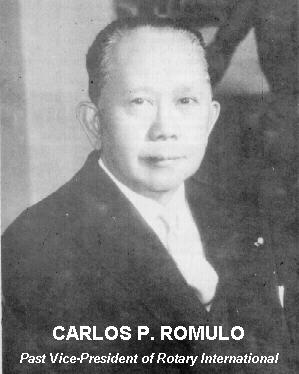 There
is a new Rotary Club in the mid-Pacific. It is the
Rotary Club of Guam and it was admitted as a member of
Rotary International on August 30, 1939. As such it is
club No. 5105. There
is a new Rotary Club in the mid-Pacific. It is the
Rotary Club of Guam and it was admitted as a member of
Rotary International on August 30, 1939. As such it is
club No. 5105.
Its officers are C. C. Butler, president; Mr.
McDurmit, vice-president; F. W. Fall, treasurer; V.
Rosario, secretary. The directors are: J. M. Flores, P.
Martinez, K. R. Miller, J. M. Torres, and B. J.
Bordallo.
The Guam Rotary Club was organized by the past
vice-president of Rotary International on July 4, 1939.
Preliminary arrangements were first made sometime in
1938 when the same officer passed through Guam on his
way to Chicago for a meeting of the board of directors
of Rotary International.
"Ray" Reynolds of the Manila Rotary was later
delegated to make a survey of Guam. C. C. Butler and
Jose M. Flores, two prominent businessmen of Guam, were
the moving spirit behind the organization of a Rotary
club.
On June 8 this year, the past vice-president of
Rotary International on his way to the Cleveland
convention, together with Messrs. Flores and Butler,
made a preliminary survey of the possibilities. The
result of this survey he reported to the board of
directors of R.I.
Returning to Manila on July 4, 1939, the provisional
Rotary Club of Guam was organized by him in the house of
Mr. Flores, at which Mr. Butler acted as the acting
chairman and Mr. Flores as the acting secretary. All the
necessary papers were perfected and the application for
membership to R. I. was sent by Clipper to Chicago.
Yesterday word was received from Chicago that the
application of the Guam Rotary Club has been approved by
the board. It is understood that the new club will have
a gala night when its charter is officially presented to
it. |
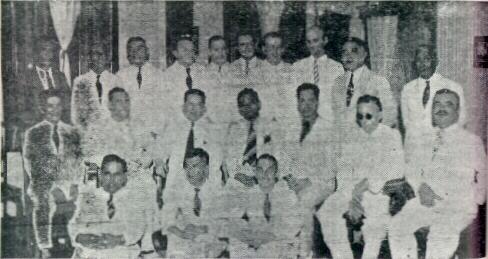
THE ROTARY CLUB OF GUAM, admitted as new member of
Rotary International on August 30, 1939, as No. 5105,
photographed in agana, Guam, when it was provisionally
organized by Carlos P. Romulo, past vice-president of
Rotary International, on his way back to the Philippines
from the Rotary International convention in Cleveland.
The organization meeting was held in the house of Former
Justice Jose N. Flores who gave a dinner in honor of Dr.
Romulo. C.C. Butler was elected president.
Those appearing in the picture left to right, are: Rev.
J.F. Sablan, T. Shinohara, P. Artero; middle row, J.K.
Shimizu, C.C. Butler, Dr. Carlos P. Romulo, J.M. Flores,
B.J. Bordallo, F.W. Fall, V.P. Herrero; back row, S.A.
Sanchez, At. R. Perez, J.M. Torres, H.W. Elliott, Dr.
H.E. Robins, K.R. Miller, A. McDurmit, A.A. Jorgensen,
P. Martinez, Judge J.M. Camacho.
|
Page 32 - 33
|
Rotary in the Marianas |
|
The first Rotary Club in the world was
organized by Paul P. Harris, a young lawyer, on February
23, 1905, in Chicago, with the object of encouraging and
fostering the ideal of service as a basis of worthy
enterprise. From its humble birth, Rotary quickly found
appeal to business men in countries outside the United
States, while it continued to develop and expand within
the United States of America.
In 1910, Rotary spread to Canada, and in 1911-12 to
England, Ireland and Scotland, in 1916-18 to Cuba and
Puerto Rico, and in 1919 to the Philippines.
It seems only fitting that in 1939, twenty years
after Rotary had spread to the Philippines, that on 8
June 1939, Messrs Justice Jose M. Flores and C.C.
Butler, two prominent businessmen of Guam, met with
Carlos P. Romulo, director and Past Vice-President of
Rotary International on his way from the Philippines to
the Rotary International Convention in Cleveland, Ogio
to make a preliminary survey of the possibilities for
organizing a Rotary Club on Guam. This was after
preliminary inquiries had been made with local business
leaders in 1938, as to whether there would be an
interest in establishing a Rotary Club on Guam.
Past Vice-President of Rotary International, Carlos
P. Romulo, reported the results of the survey to the
Board of Directors of Rotary International, and, on his
return trip to Manila on 4 July 1939, the provisional
Rotary Club of Guam was organized by him in the house of
Justice Jose M. Flores with Mr. C. C. Butler as Acting
of "Ray" Reynolds of the Manila Club, all necessary
papers were perfected and the application for membership
was sent to Rotary International in Chicago by Pan
American Clipper.
On 30 August 1939, the Rotary Club of Guam was
admitted as a member of Rotary International as Club No.
5105, and the original Charter was issued and signed by
Walter D. Head, President of Rotary International and
Chester R. Perry, Secretary of Rotary International, on
that date.
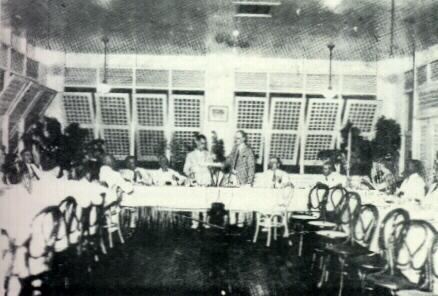
The presentation of the Charter to the Rotary Club of
Guam was made on the 21st of October 1939 by then
Justice of the Philippine Supreme Court, George Malcolm,
an active Rotarian from Manila, who was enroute from the
Philippines to the U.S. mainland via the now famous
California Clipper; this day accordingly, became Charter
Day for the Rotary Club of Guam.
While details of the Charter Day presentation, like
so many of the early records of the club have been
destroyed by ravages of time, the devastation of war and
the severe typhoons which visit our island, it is easy
for anyone who has had the privilege of attending a
local fiesta, rich Spanish and Chamorro tradition to
visualize what a gala occasion this must have been.
From the records which have come down to us, we know
that the ceremonies included a presentation speech by
Justice Malcolm, a response by Mr. C. C. Butler, the
first President of the Guam Rotary Club and a banquet at
the then George Washington Auditorium at Maite,
featuring local entertainment.
From the initial 20 charter members, the membership
grew to 29 when Guam was occupied by the Japanese on 8
December 1941. |
Charter Members
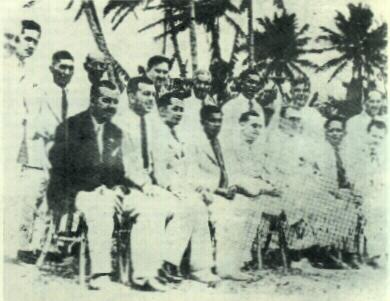 |
C.C Butler
Jose M. Flores
B.J. Bordallo
A. McDermit
F.W. Fall
Jose M Torres
K.R. Miller
S.A. Saunders
A.A. Jorgenson |
V. Rosario
A.T. Perez
E.T. Calvo
Jose M. Camacho
J.K. Shimizu
Simon A. Sanchez
Trinidad T. Calvo
Jose G. Eustaquio
M.S. Sqambelluri
T. Shinohara |
|
First Board of Directors |
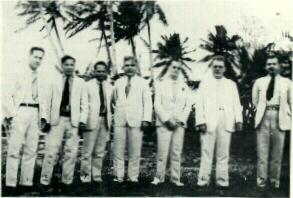
B.J. Bordallo, V. Rosario, J.M. Flores, P. MArtinez,
C.C. Butler, A. McDermit, K.R. Miller |
|
|
Page 34 - 35
1939-40 - C. C. BUTLER, President
Some insight into what Guam was
like when the first Rotary Club was formed may be
obtained from the following address made by President C.
C. Butler at the meeting held December 5, 1939 as taken
from the January 1940 issue of the Guam Recorder: |
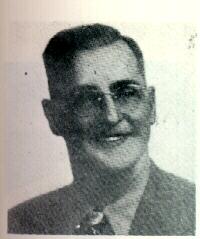 "If
you desire to be one of the outstanding business men, be
optimistic. Have faith and confidence in the
administration of the Naval Government of Guam. It is
amazing what it has done here in the past 40 years.
Knowing what it has done gives me confidence. "If
you desire to be one of the outstanding business men, be
optimistic. Have faith and confidence in the
administration of the Naval Government of Guam. It is
amazing what it has done here in the past 40 years.
Knowing what it has done gives me confidence.
"As I look back of the 29 years I have been in Guam,
I can see wonderful changes, especially in the business
field. I remember when I first came here, there were
very few Chamorro people in business. A German, by the
name of Costenoble, had a chain of stores - eight, I
believe in all - and, there were a few Japanese people
with stores. Today, most all of the business houses are
conducted by citizens of Guam. Education brought this
about. In the old days, Spanish coppers and Mexican
dollars were in circulation. The exchange value on the
coppers were 4 for one American penny, and the Mexican
dollar 50 cents. One seldom sees these coppers and 'Mex'
dollars now. And at that time one could exchange a plug
of old Navy chewing tobacco for twice its value in
merchandise. That was in the bartering days. The old
coins have gradually disappeared and the Navy tobacco is
slowly disappearing from the stores.
"During those days, Army Transports brought out
commercial cargo every month, free of charge, and the
shipments came in a very good condition, with the
exception of an occasional barrel of beer being lost.
But at that it was very convenient for the few merchants
to receive shipments, and they could depend on it
monthly.
"There were no automobiles or trucks. Bull carts and
one or two dray wagons were the only means of
transportation from Piti to Agana, and bull carts, as
you all know, are slow. But of course there was not much
cargo brought in at that time. It would look odd,
indeed, to see bull carts hauling freight now.
"The old Customs house, built in 1911, housed both
Government and commercial freight. The present Customs
house, when built, was believed to be amply large enough
to stow all shipments for many years to come. But it was
not long before this Customs house became too small for
commercial goods. Sooner or later an addition will have
to be added to this one.
"As I look at business today, I recall all these
facts of the past. But I can see prosperous years ahead.
In fact, I have seen nothing but prosperous years since
I have been in Guam. It can be nothing else -- barring
wars and catastrophes. Why? Because, besides the
government's close cooperation with businessmen,
health conditions have improved, so much so that
epidemic of dysentery, measles, typhoid fever and the
like, that formally (sic) killed people off by the
hundreds, are almost a thing of the past. And this is
all to the credit of the Naval Government. The
population of Guam has been on the increase, year by
year. The population has more that doubled during the
past 20 years.
"An increase in population encourages the opening of
new business enterprises. In ten years from now, I
believe we are going to see unbelievable business
improvement. Memories recall many commercial ventures
some of which are, The Bank of Guam; Pedro's Ice and
Cold Storage Plant; Bordallo's Cold Storage Plant;
Torres' Soap Factory; Photo Shops; Restaurants;
Refreshment places; Barber Shops; Bakeries; Taxi Cabs;
Bus Lines; a Saw Mill; the Globe Wireless, the Weaving
Industry, the Tile Factory, up-to-date dry goods and
grocery stores, (such as Flores Trading Co., Calvo's
stores and Atkins Kroll & Co.); Pan American Airways and
naturally last but not least my bottling plant.
"And there are other enterprises which are bound to
grow up here in time to come. Let me mention a few.
There is the dairy business, a laundry and dry cleaning
establishment, an electric light plant, a hotel, a
brewery, a steamship company, a telephone co., a life
insurance co., a dentist and perhaps an eye, ear, nose
and throat specialist. There are but a few, but, I
believe there are openings for these few at this time.
We have the Bank of Guam ready to finance anyone with a
good proposition, and the people of Guam should be the
ones to start these enterprises before outsiders
discover their possibilities.
"As the population increases, people will find ways
and means of earning a living. That is but natural.
Believe in your government and don't worry over hard
times. As new business firms are established there is
opened up new classification for membership, and
naturally, the Rotary Club will benefit. And the island
will benefit the merchants and all concerned.
"I believe it is up to the Rotarians to promote new
enterprises -- there being no Chamber of Commerce here
to do it. As a business and professional men we must
feel it our duty to work for the community interests,
and a new line of business is of interest to this
community." |
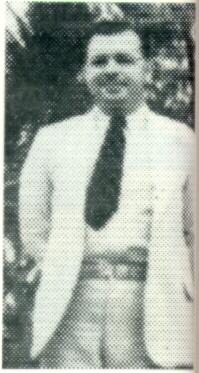
K.R. MILLER - 1940-41, President |
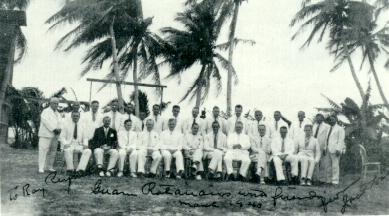
GUAM ROTARIANS AND FRIENDS 1940
|
|

